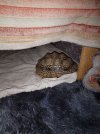TortieMoonshade
New Member
We have a recently rescued mature leopard tortoise and she eats anything and everything that looks remotely like food in sight, including the curtain. She was rescued from a squatter camp where it is generally barren of vegetation so I was wondering if it is because she was starved for some period of time and it's a coping mechanism, the same way a neglected dog or cat would do?
Will this cause her to become obese since she lives in our large, confined outdoor garden with grass and she eats the grass too? How do I prevent this?
She also doesn't hide at all, she runs like I've never seen a tortoise do when she's scared? Probably realized that hiding won't help because our native South African people cook and eat tortoises.
Thank you very much for your support
Will this cause her to become obese since she lives in our large, confined outdoor garden with grass and she eats the grass too? How do I prevent this?
She also doesn't hide at all, she runs like I've never seen a tortoise do when she's scared? Probably realized that hiding won't help because our native South African people cook and eat tortoises.
Thank you very much for your support
